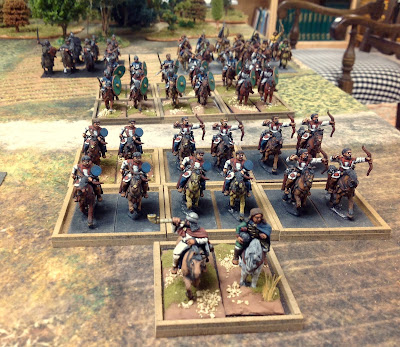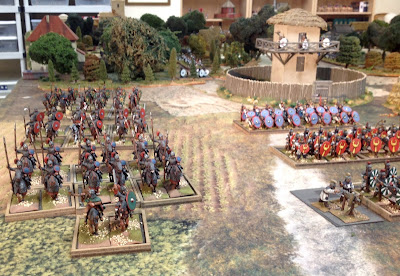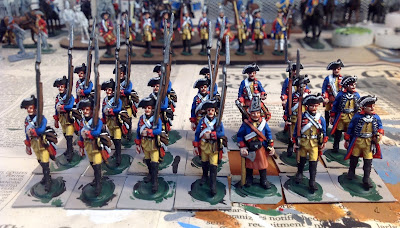 |
| Der Alte Fritz answers questions from play testers of his new Kleine Krieg rules. (click to enlarge the picture) |
I have a number of play testers working on my Kleine Krieg skirmish rules for the Seven Years War and I am getting some good feedback that I thought that I would share with my readers. The questions and the answers are shown below:
Question 1 - Initiative: Do you dice to determine who goes first, as in your rules for larger battles, or is there a different method?
Answer: Initiative is determined by the draw of a card from a deck that you create prior to the start of the game. I make my own cards by cutting them out of cardboard. Each unit in the game will have two cards with its name on the card. All cards for all units are shuffled together and the draw of the card determines which unit gets to perform an Action first. Note that any unit can theoretically draw two consecutive cards and thus perform back to back Actions.
Question 2 - In the turn order: move, shoot, melee and morale (and when for morale). Should it be on the play sheet?
Answer: The turn order is determined by each player when one of his cards is drawn from the card deck. A player may decide that he wants to shoot on the first turn; or move first; or charge into melee, etc. There is a box on the back of the QRC sheet labeled "When to Check Morale" and such checks are taken when
1) Charging unit takes casualties during the charge
2) Defender decides to Stand to a charge
3) Melee loser tests morale
4) Officer or personality figure casualty that occurs on the current game turn
Note that units do not have to test morale when they take casualties from firing (except if taken during the charge - see event 1) above.
Question 3 - Two actions in one turn feels like a lot for a small skirmish game on a smaller 4ft by 6ft table, especially when units are within 18-inches (which is the musket range).
Answer: the rules are flexible and feel free to make changes during your play testing. On a smaller 4x6 table I would recommend using smaller units of, say, 12 figures instead of the 12 to 24 figures that I use in my skirmish game. You could also experiment with reducing all ranges and movement by half.
Question 4: I do like the idea of a reload as an Action which stops people blazing away willy nilly twice in a bound. It makes it more of a tense game in timing a charge or movement when close to an enemy - are they going to reload in time?
Answer: a "reload" Action is an interesting idea that I will consider adding to the rules. I kind of like the idea of a dastardly Croat letting the Prussians have it in the face on consecutive actions. On the other hand, if there were a "reload" Action in the rules, a unit might want to only fire half of its unit (e.g. fire 6 of 12 figures in a unit) while the other half of the unit holds its fire. Thus the other six figures can fire at an opponent and cover the other half who are reloading.
Question 5: When a unit takes a casualty how do you decide who is hit? I did a dice roll to count along the unit's line, in the manner of the Featherstone and Grant rules.
Answer: My perusal of the rules sheet indicates that the officer casualty procedure is not listed on the rules sheet. Originally, I was using a deck of regular playing cards to determine fire effects and if an Ace card was drawn, then the fire effect applied to the officer in the unit or the Personality figure if he was attached.
I think that your solution is a good idea. So roll a D6 and start counting from left to right along the line of the unit's figures. Thus a roll of "5" indicates that the fifth figure from the left would be the casualty. Or maybe roll two D6 if it is a 12-figure unit.
Question 6: It felt odd with both the winning and losing sides in a melee taking prisoners. Should the winners (sic - "losers" perhaps) just retire?
Answer: Melees are fought on a one to one basis, or up to a maximum of three figures picking on one unfortunate Joe if one of the sides has extra figures in its unit (e.g. one side has 6 figures and the other side has 9 figures - thus one side has three extra figures that it can match up with other melees in the fight. In this instance the extra figures can double up on one figure first, rather than adding two more figures , that is 3 to 1. If there are still extra figures after all figures have doubled up on the opponent, then the third figure can join the melee).
It might be a good rule change to have the losing side in the melee retreating and releasing its prisoners. Thus only melee winners retain captured prisoners.
Question 7: The melee system seems a bit fiddly. I do like the one on one combat ( as in The Sword and the Flame rules). Could the hit and casualty outcomes be shown from the difference in the initial opposed rolls rather than having to roll dice again?
Answer: There is only one dice roll in a melee. The one die roll applies to both the combat part of the melee and the melee outcome result.
The winner of a one on one melee is the figure that rolls the higher number on its combat dice roll. For example, if Player A rolls a "12" on a D20 and Player B rolls a "9" on a D20, then Player A wins the melee. Player A now consults the Melee Results Table and sees that the "12" that he rolled in the melee translates into a Kill outcome (a roll of 12 to 20 is a kill).
If we were to "net out" the opposing numbers, in this case a 12 less a 9 equals a 3 outcome which translates to "loser taken prisoner". The result can be substantially different if the die rolls are netted against each other. If you want to try netting the dice scores, the I would recommend reducing the Melee Effects by half (e.g. a 20 roll become a 10 roll and the 12 to 20 roll outcome of Kill is changed to 6 to 10 equalling a Kill outcome.
For those readers who do not have a copy of the rules in front of them, the melee results table:
On a D20, Melee Results are:
12 to 20 Kill
9 to 11 Wound inflicted on the loser
5 to 8 Flee, the loser retires 12-inches
1 to 4 Loser is taken prisoner
Halving the above table changes the outcome buckets to 6 to 10 = Kill; 4-5 = Wound; 2-3 = Flee, and a 1 = Loser taken prisoner.
I think that the play tester asked a lot of good questions and found a couple of logic holes in the rules. I appreciate all feedback from our play testers. The rules are not set in stone yet so I can still change mechanics that either don't work or produce odd results.
I welcome comments from readers who are not play testers. Just write your observations and opinions in the Comments section of this blog post.































